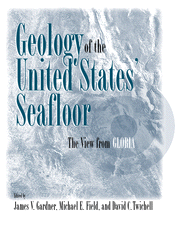Book contents
- Frontmatter
- Contents
- Contributors
- Foreword
- Introduction
- Part I The GLORIA System and Data Processing
- Part II U. S. East Coast EEZ
- Part III Gulf of Mexico and Caribbean EEZ
- Part IV U. S. West Coast EEZ
- Part V Alaskan EEZ
- Introduction
- 15 Sediment Pathways in Gulf of Alaska from Beach to Abyssal Plain
- 16 Sedimentation Along the Fore-Arc Region of the Aleutian Island Arc, Alaska
- 17 Aleutian Basin of the Bering Sea: Styles of Sedimentation and Canyon Development
- 18 Geology of the Kula Paleo-Plate, North Pacific Ocean
- Index
17 - Aleutian Basin of the Bering Sea: Styles of Sedimentation and Canyon Development
Published online by Cambridge University Press: 25 January 2010
- Frontmatter
- Contents
- Contributors
- Foreword
- Introduction
- Part I The GLORIA System and Data Processing
- Part II U. S. East Coast EEZ
- Part III Gulf of Mexico and Caribbean EEZ
- Part IV U. S. West Coast EEZ
- Part V Alaskan EEZ
- Introduction
- 15 Sediment Pathways in Gulf of Alaska from Beach to Abyssal Plain
- 16 Sedimentation Along the Fore-Arc Region of the Aleutian Island Arc, Alaska
- 17 Aleutian Basin of the Bering Sea: Styles of Sedimentation and Canyon Development
- 18 Geology of the Kula Paleo-Plate, North Pacific Ocean
- Index
Summary
Abstract
The present-day physiography and Quaternary sediments of the Aleutian Basin of the Bering Sea are the culmination of an evolution most recently dominated by mass wasting. These processes have modified the structural framework produced by plate convergence during early Tertiary time. The products of mass sediment transport are so pervasive as to make the Aleutian Basin possibly the world's best example of a basin and margin modified by these processes.
Three provinces, fan, debris flow, and basin plain, characterize the upper 50 m of sediment in the Aleutian Basin. Sediment reaches the floor of the Aleutian Basin through numerous canyons and gullies of the insular and continental slopes and through three main canyon-channel systems: Bering, Umnak, and Pochnoi channels. Bering Channel, morphologically the most impressive of the three, extends for more than 500 km and terminates in a presumably young submarine fan. Bering Fan, lacking the sloping wedge geometry and the upper-, middle-, and lower-fan subdivisions that are commonly used to describe submarine fans, resembles a single depositional lobe. Sediment shed from the Aleutian Island Arc and Bowers and Shirshov Ridges has been transported down the flanks of these features resulting in debris flow deposits that have accumulated around the perimeter of the Aleutian Basin. Two debris flows that originated from the Aleutian Arc (Umnak and Pochnoi) are dominant among the debris flows that occupy the perimeter of the basin. Umnak debris flow is the youngest of the debris flow deposits and overlies the margins of Bering Fan.
- Type
- Chapter
- Information
- Geology of the United States' SeafloorThe View from GLORIA, pp. 305 - 332Publisher: Cambridge University PressPrint publication year: 1996



